‘Kya leke milein ab duniya se, aansoo ke siva kuch paas nahin,
Ya phool hi phool the daaman mein, ya kaanton ki bhi aas nahin’
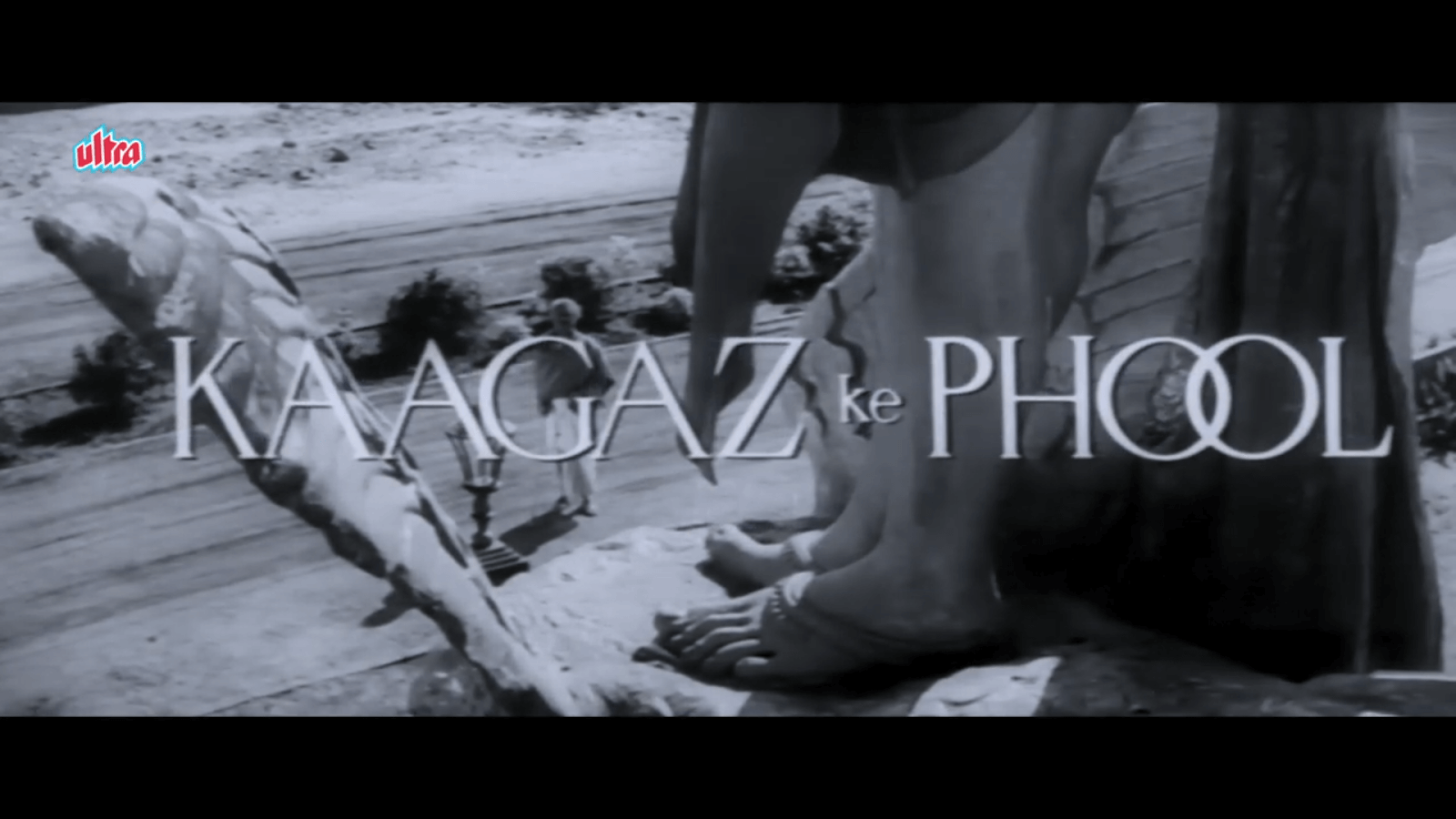
Into the world of Kaagaz Ke Phool
As a filmmaker, I am always double curious for films which are about a filmmaker or which revolve around film sets, shooting etc. Naturally, I find a connection with such films. It feels as if somewhere my story is being told. So when I watched Kaagaz Ke Phool, I felt I was there with charismatic Suresh Sinha, witnessing everything that was going on in his life.
But surely, there is more to Kaagaz Ke Phool. Guru Dutt’s autobiographical drama has all the elements of a good cinema which makes it a masterpiece. It should be noted, although, that this cult cinema failed miserably both commercially and critically at the time of its release. This result was followed by Dutt taking a big decision of his career.
Kaagaz Ke Phool was produced and directed by Guru Dutt. Under Guru Dutt Films, it was the maker’s most ambitious project. Guru Dutt had this story in his mind since long, even before he made his debut as a director with Baazi (1951). He had high expectations from this film. After giving successful films one after the other, Guru Dutt had already established himself as an auteur. Now, he wanted to soar higher into the sky. Kaagaz Ke Phool is said to be Guru Dutt’s autobiographical film. The film stars Waheeda Rehman alongside Guru Dutt in a quite unique role as Shanti. Much has been already said about Guru Dutt’s relationship with Waheeda Rehman. The two collaborated on numerous projects starting with C.I.D. If you read about Guru Dutt and Waheeda Rehman, you’ll find striking similarities between the real and reel life as shown in Kaagaz Ke Phool. Written by Guru Dutt’s close aid Abrar Alvi, the film boasts of a near to perfect screenplay with some memorable dialogues that’ll etch in your mind forever.
Kaagaz Ke Phool was launched a year after Pyaasa (1957). Already on cloud nine with the resounding success of Pyaasa, Guru Dutt now wanted to make a film which would be a bigger hit than C.I.D. (1956) and Pyaasa combined. He also wanted to break some cinematic grounds through this film. He was a filmmaker who always kept experimenting with techniques of filmmaking. This is what makes him a unique and distinguished filmmaker.
Kaagaz Ke Phool is an elegy to a filmmaker’s dream. The film opens with an old man opening the gate of a film studio. He is wrapped under the old tattered shawl, and with feeble steps makes his way inside. Through a crane shot, we get a wide view of the man’s surroundings as on the top right corner of the screen a board appears with “AJANTA PICTURES” carved on it.
In the very next shot, we see the man standing at a point from where the feet of the statue is in foreground and he is in the background. From the beginning till here, this scene is beautifully accompanied by the background score – the tune of Waqt Ne Kiya Kya Haseen Sitam. The frame freezes there as the opening credits begin to roll.
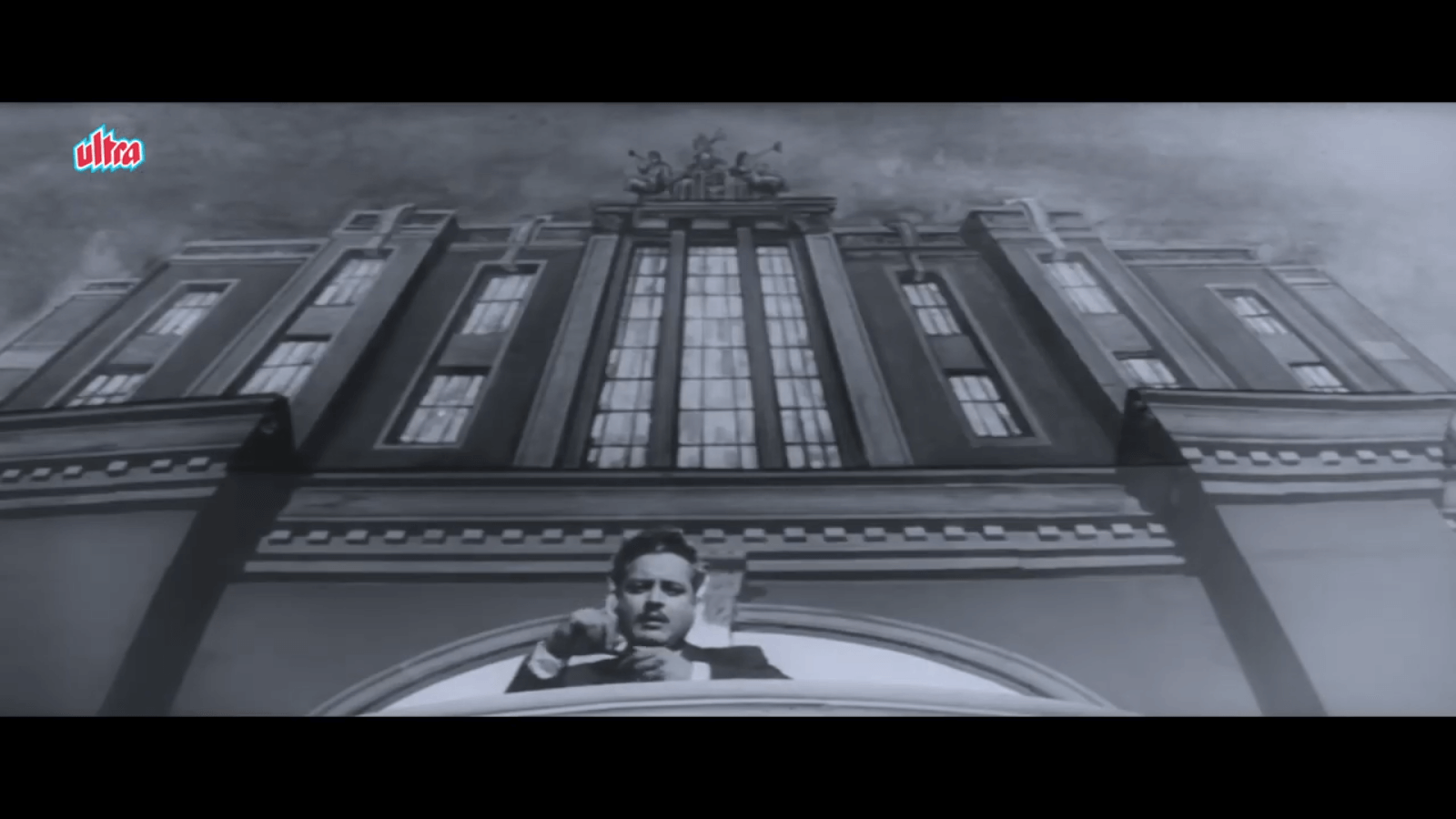
Through a cinematic gaze: Guru Dutt in Kaagaz Ke Phool
Kaagaz Ke Phool is a story of a successful yet troubled filmmaker who falls in love with a woman whom he later transforms into a star, while his own marriage has fallen into jeopardy. The above mentioned scene can be said to be a sum up of the film’s plot. Suresh Sinha enters Ajanta Pictures’ studio, a place where once he was a successful filmmaker himself. But his ambitions and aspirations were crushed by the mighty feet of the financiers and producers who don’t recognise his talent and try to snatch away his creative freedom. The background tune of Waqt Ne Kiya… aptly gives us a hint of the cruelties time bestowed upon Suresh.
Next, we see Suresh entering the set of a film. It’s early morning and no one has arrived there yet. It’s all dark inside. His eyes scan his surroundings. Lights, cameras, director’s seat, costumes, props, trolleys etc. everything is kept at its place. As he enters the set, we hear the narrator speaking in the background:
“Ye ek studio mein daakhil hue hain. Is studio mein na jaane kitni picturein ban chuki hain, ban rahi hain aur banti rahengi. Lekin ye studio nahin badla, aur na hi yahaan ka mahaul badalta hai. Sab kuch wahi hai. Sirf picturein badalti rehti hain yahaan aur picture banaane wale badalte rehte hain. Ek zamaana tha jab ki ye bhi yahaan picturein banaaya karte the.”
Through the narration, we are told that the man entering the studio was once a filmmaker himself. The narrator also philosophically explains the passage of time and that change is the only constant (Sirf picturein badalti rehti hain yahaan aur picture banaane wale badalte rehte hain). This short narration and a very brief introduction of the man whose name we don’t know yet makes up for a perfect beginning. Moments later, we see the lights being turned on inside the studio as the crew has arrived. The technicians have started their day’s work setting up a scene. The day has started. The old man quietly makes his way up the stairs as a melodious voice starts humming a song. The voice is none other than Mohammed Rafi’s. The song is Dekhi Zamaane Ki Yaari.
Through the first few lines of the song, we are already made curious as to what must have entailed in this unknown man’s life. Why is he lamenting over the loss of people who have probably left him? His life looks like an ocean of sorrows and you can’t help but feel empathetic towards him. His eyes are filled with tears as he looks down at the activities going on the set. One can also notice the longing and despair in his eyes. It tells a lot about his passion for filmmaking. As the camera zooms in on the man, he reminisces his days as a filmmaker. The frame dissolves and the image of a lotus pond appears where a stone is dipped into the water. The face of the man is then juxtaposed with the images of lights and cameras and next we see is the shot of people clapping and coming out of the cinema hall with big smiles on their faces. It’s the premiere of Vidyapati. The man who is receiving these applauses is standing by the balcony of the theatre. The low angle shot captures his steady and yet warm look as he looks down at the road. Then, he turns back and moves in with a smoking pipe between his lips. The man is Suresh Sinha.
The song continues as we hear the lines, “Waqt hai meherbaan, arzoo hai jawaan…fikar kal ki karein, itni fursat kahan?” Thousands of women and men with autograph books in their hands are eager to get Suresh’s autograph. Guru Dutt here, with his signature smile as Suresh, wins hearts as he begins signing his autograph.
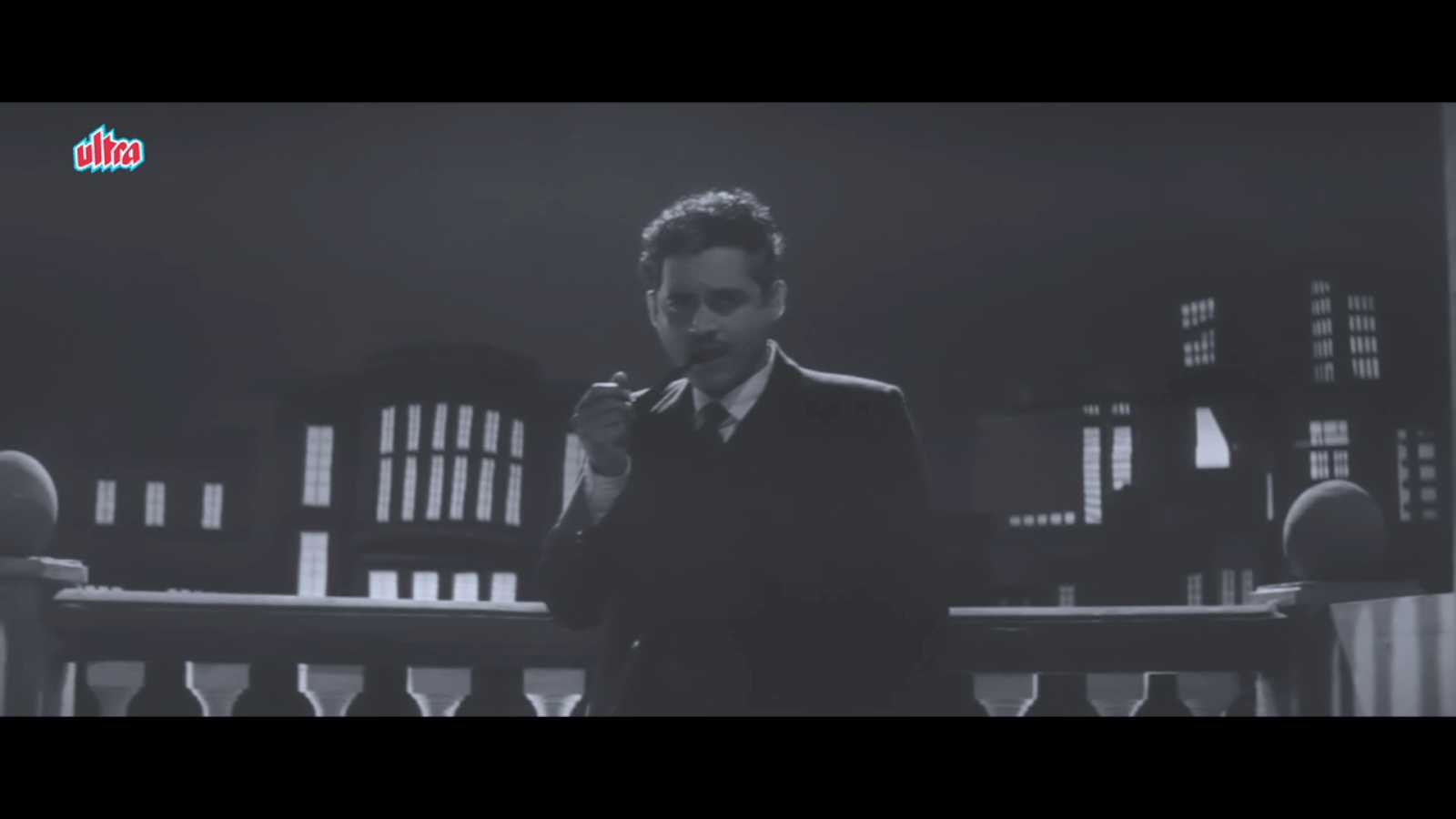
Waqt Hai Meherbaan, Arzoo Hai Jawaan: Iconic pose by Guru Dutt
As we move ahead in the film, we see the kind of a man, or say director, Suresh is. When he arrives at the studio in his car, he is greeted by everyone – spot boys, technicians, light men etc. This tells a lot about his personality and nature. He always arrives on time – 9 a.m. sharp, as the telephone operator (Tun Tun) notices. Suresh Sinha values art more than commerce. He doesn’t see art as a business and thus is never ready to compromise on his story, characters, dialogues, music etc. When he enters the recording room, the music director talks nonsensically about the tune that he has created for a scene of his upcoming film Devdas. Suresh is visibly irritated. He doesn’t like to waste time and talks straightforwardly. He sternly asks him to play the tune. The music director obliges.
In another scene, the producer, financiers and the film’s leading actress are sitting in a room. The latter is crying as she is not allowed to wear jewellery or even make up her hair as Paro. Suresh wants his Paro to be simple without any heavy makeup. He has imagined her that way and in no way is going to compromise. He says, “Character ke hisaab se aapko badalna hoga. Aapke hisaab se character nahin badla jaayega.” In the end, when she threatens not to work in the film, he only says “Thank you” in response. The producer also tries to take her side and tells Suresh, “Yahaan tum zyaadati kar rahe ho Suresh.” And an adamant Suresh hits back, “Agar maang tirchhi rakhni hai to phir picture bhi kisi aur se banwa lijiye.”
These traits establish the character of Suresh Sinha and tell us the kind of director that he is. It is because of the same reason that producers and financiers often argue with him.
Next, we are introduced to Suresh’s world – his home. His car stops at the house as the lines in the background go, “Raat bhar mehmaan hain bahaarein yahaan, raat gar dhal gayi phir ye khushiyaan kahaan…” Suresh enters his house and the wide shot capturing the walls, doors and moving curtains tell us that he lives alone. The loneliness and melancholia is right there which gives us a hint into Suresh’s life. The house represents Suresh’s state in the perfect manner possible. Guru Dutt’s idea of using the house as a symbolism for Suresh’s condition is brilliant. Moments later, we see him opening the drawer and picking up a doll that was kept inside. This gesture is enough to tell us that he has a daughter.
Next, we see him at his daughter Pammi’s (Baby Naaz/Kumari Naaz) boarding school in Dehradun. The way they both hug each other tells a lot about their equation. Their moment of togetherness is only interrupted by Pammi’s warden who asks her to stay off her father as she is not allowed to meet him. This scene is heartbreaking and the anguish on Suresh’s face of not even providing access to his own daughter says a lot. Suresh then goes to his wife Bina (Veena) and in-laws’ place to discuss a few things about his daughter. The scene opens with the old couple sitting by the fireplace. Bina’s mother is arranging the playing cards while her father B.P. Verma is sleeping on the chair with a magazine laying open on his chest. On another sofa, a dog is sitting with his tongue out. This establishment shows the elitist and colonial family of Bina. It is further expanded when the dog barks, signalling the arrival of Suresh. Bina’s mother breaks the silence as she responds to the dog with, “Poor child! What? Oh! Suresh!” The use of language here also tells us about the colonial atmosphere of the house. The confrontation between B.P. Verma and Suresh begin as the latter tells his purpose of arrival. B.P. Verma is mostly ignoring him and in his show of arrogance and elite pride, mostly talks about their puppy Lulu whose voice seems low to him and who is always coughing. B.P. Verma’s constant attention towards his puppy rather than his son-in-law shows the importance the latter holds in this family – less than an animal.
There is also a stark contrast that we get to see in this family through this scene. No matter how much pride Verma family holds in being the upper class and privileged one with fine English always on the edge of their lips, they still have strict reservations against films and film industry. Not surprising enough, this is the main reason for Suresh and Bina’s separation. When Suresh tells them sternly that he wants Pammi to stay with him, B.P. Verma retaliates instantly, “Nonsense! Sir B.P. Verma ki nawaasi filmon ke gande mahaul mein rahe? Impossible!” Next, Mrs. Verma too laments about the same, “Hum jaisa badnaseeb duniya mein koi bhi na hoga Suresh. Oonchi society mein humein ye kehte hue sharm aati hai ki humaari beti shaadi shuda hai. Kyunki tab log humse poochhte hain ki iska shauhar kya kaam karta hai? Dear me (she sighs)! Shaadi se pehle humein ye kyon na maloom hua ki ek din tum films mein jaaoge?” Suresh doesn’t understand their contempt when it comes to cinema. It’s all evident on his face as he has just one expression of perplexity and irritation. As if he had it enough, he comes up with a valid question,“Mujhe samajh nahin aata aap log film line ko itna bura kyun samajhte hain?” is the question he asks. This is the same question we, as viewers, ask ourselves while watching this scene. Bina’s family is a portrayal of upper class society which hides their regressive thinking under the garb of elitism.
These first few scenes of the film take us into the melancholic world of Suresh Sinha, the filmmaker. Although a successful filmmaker, he is a failure in his life. The wide shots of his house and the scenes involving Pammi and his in-laws describe
Kaagaz Ke Phool is also said to be a homage to Gyan Mukherjee who directed Kismet (1943). Guru Dutt was fond of the filmmaker who was famous in the 1940s. It was during this association with Mukherjee in 1950 that Guru Dutt became quite influenced by the filmmaker, mostly by his life and tragedy. It put the seed for the film which would be remembered for years for its experiments and techniques.
Kaagaz Ke Phool is about humans and their quest with destiny and fate. If you see the film clearly, you’ll notice there are actually two plots running simultaneously – one is Suresh’s plot as a filmmaker where we see him rising high and then falling down miserably when he is not allowed creative freedom that he seeks, and the other is about his troubled married life with Bina which goes from bad to worst and his close association and bonding with Shanti which doesn’t come to fruition due to the circumstances that separate them. The common link between the two is Suresh who is tested in life so much that he isn’t able to stand up on his feet again.
Guru Dutt’s style of filmmaking was different from his contemporaries. He has always experimented with techniques in his films and Kaagaz Ke Phool consists of many of them. His experiment with light and shadow is evident throughout the film. Apart from the experiments, it’s the empathetic nature prevalent in Dutt’s classics which are extraordinary too. In Pyaasa, Dutt’s character of a struggling poet Vijay empathises with the poor and the oppressed and voices his rage against their oppression through his poetry which he also experiences. In Kaagaz Ke Phool, Suresh is seen waving at his crew from his car – be it lightmen, spot boys or any other technician. Even the receptionist at the studio respects him. In both the films, we see how Guru Dutt is quite sensitive about the working class and poor people and uses his empathy for them brilliantly in his films which also serves as a lesson that we should learn. One of the scenes in Kaagaz Ke Phool shows Suresh’s empathy towards the poor when he overhears his assistant yelling at the poor woman in the make-up room as she was hired as an extra for a scene but due to her baby who was crying continuously, she wasn’t able to show up on time. Suresh then quickly enters the scene and scolds his assistant who leaves immediately. From here, he takes the charge and tells the woman not to hurry and come to the set only after feeding the baby. He then turns towards the elder daughter and asks her name. We see the father-figure in Suresh here which further tells us how much he misses his own daughter Pammi.
‘Sardi-zukaam muft milte hain, garam coat ke liye paise lagte hain’: Waheeda Rehman with Guru Dutt
The usage of the coat in both the films falls under the same bracket but stands out differently. Coat acts like a metaphor for his empathy and care for the poor. In Pyaasa, it was the beggar who gets the coat from Vijay, an act of empathy from a poet. In Kaagaz Ke Phool, it is Shanti who gets the coat around her from Suresh, an act of care from a filmmaker. We also see the force of nature as a cause for the protagonist’s empathetic behaviour in both the films. In Pyaasa, it was the chilling weather which prompted Vijay to remove his coat and give it to the beggar who was shivering with cold. In Kaagaz Ke Phool, it’s heavy rain which prompts Suresh to take off his warm coat and offer it to Shanti as both stand under a tree to protect themselves from the rain. It’s a beautiful scene from the film where Shanti is introduced to the audience and the two protagonists (Suresh and Shanti) meet for the first time, not knowing of the bonding and relationship that they would form later.
Shanti: *sneezes*
Suresh: Hello!
Shanti: *doesn’t respond and sneezes again*
Suresh: Zukaam ho gaya hai aapko?
Shanti: *looks at Suresh and then looks away, still silent*
Suresh: Mera matlab tha kuch ajeeb sa mausam ho gaya hai.
Shanti: *sighs*
Suresh: Maaf kijiyega aap kahin goongi…
Shanti: *looks at him in anger and then begins* Mera naam poochhna bekaar hai, aaj sham ka khaana main hostel mein khaaungi, mujhe cinema-unema dekhne ka koi shauk nahin!
Suresh: Ji?
Shanti: Ji
Suresh: Lekin aap ye sab mujhe kyon bata rahi hain?
Shanti: Isliye ki aajkal ke gentlemanon ke bare mein yahi sun rakha hai, agar kisi ladki se akele mein mulaqaat ho jaaye, to number ek hello, number do mausam ki baatcheet, number teen naam poochhna, number chaar khaane ya picture ki daawat dena, number paanch…
Suresh: Bas bas! Tab to main aadha gentleman hoon. Dariye nahin! Main number do ke aage nahin badha karta.
Shanti: Sachmuch?
Suresh: Bilkul!
Shanti: Then I am so sorry. Main aapko ghalat…(sneezes).
Suresh: Number ek zukaam, number do itni sardi! Aap apna garm coat saath kyon nahin laayin?
Shanti: Sardi-zukaam muft milte hain, garam coat ke liye paise lagte hain.
Suresh: Ye lijiye…lijiye abhi (gives his coat to Shanti).
Shanti: Lekin aap?
Suresh: Mujhe zukaam nahin hoga. Thodi si brandy pi rakhi hai.
Shanti: Huh! Sharaab pi rakhi hai? Suna hai log sharaab peekar badi badtameeziyaan karte hain!
Suresh: Kuch log doosron ki badtameeziyaan bhulaane ke liye bhi pi lete hain.
In this scene, we are introduced to Shanti. Shanti is an orphan living at a hostel. She is poor and doesn’t have money to buy a coat (Sardi-zukaam muft milte hain, garam coat ke liye paise lagte hain). Suresh gives her his coat. Through this conversation, we come to know of Shanti as a woman who is innocent and bold at the same time. She is not the one to be wooed easily and is clearly bold enough to say ‘No’. Suresh, on the other hand, is not a womanizer. He clears it to Shanti that he isn’t of that kind (Dariye nahin! Main number do kea age nahin badha karta). Here, we also see how he perceives women and how he behaves with them. Towards the end, we also come to know of the anguish residing in Suresh’s heart where he opens up a bit about it to Shanti which is probably the first step towards their relationship that would form later (Kuch log doosron ki badtameeziyaan bhulaane ke liye bhi pi lete hain). It is quite obvious whose ‘badtameeziyan’ Suresh is referring to.
Kaagaz Ke Phool celebrates ‘Guru Dutt-ism’ in fashion. Barring the leads, it consists of all the regulars of Guru Dutt cinema. From the technical point of view, the film consisted of famous Guru Dutt shot and was quite experimental in its filming shots and sequences in the scenes.
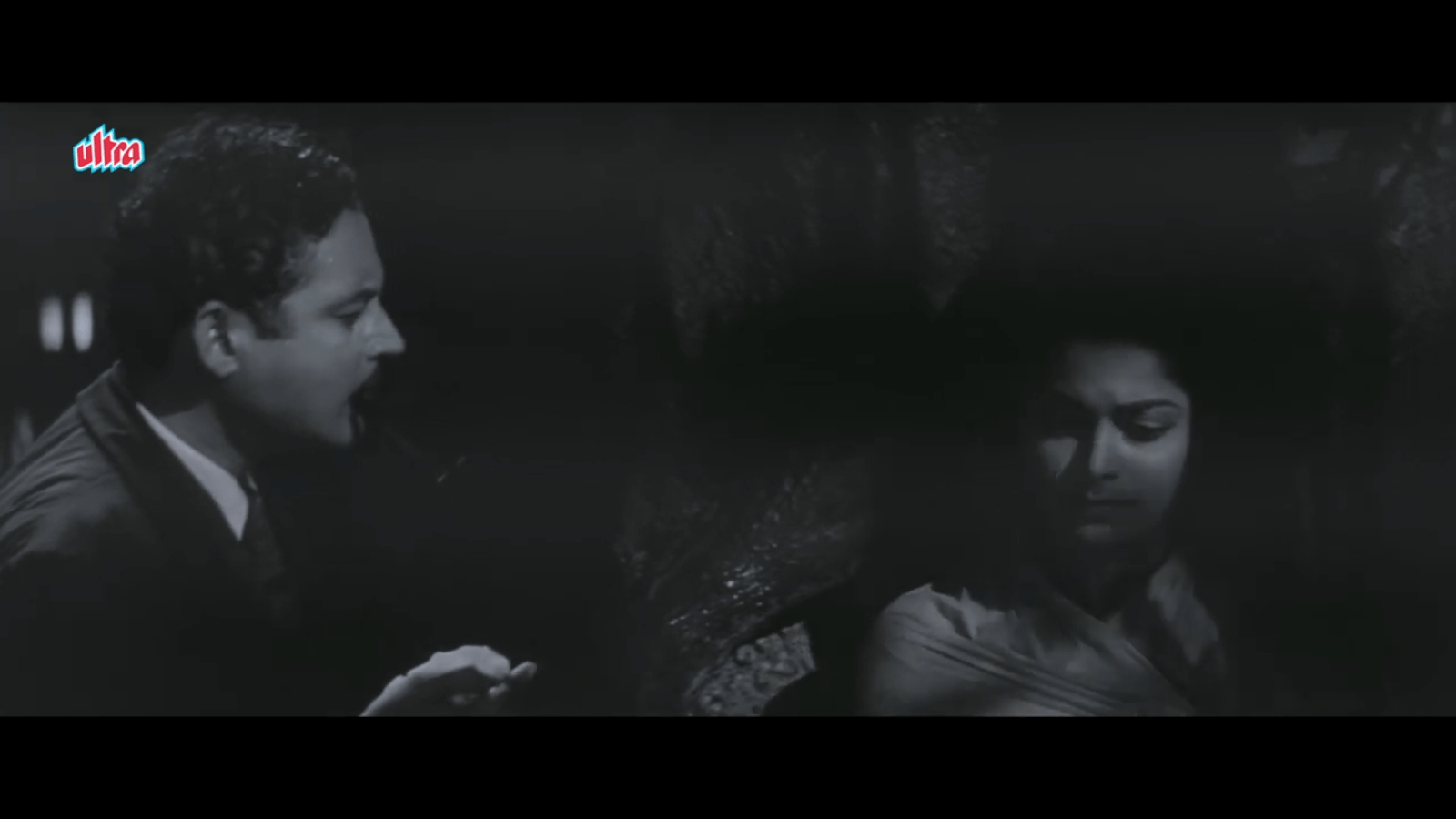
TALKING ‘TECHNICALLY’
Kaagaz Ke Phool was India’s first cinemascope feature film. Guru Dutt, after the success of Pyaasa, was so confident by now. He wanted to make another film where he also thought of experimenting filmmaking techniques. He was the man who would always vie for something new and valuable and would incorporate those technical developments in his films. He was quite serious in his filmmaking. As a filmmaker, there is hardly any difference between Suresh Sinha and Guru Dutt, I believe.
The screenplay was written by Dutt’s close associate and scriptwriter Abrar Alvi. He was someone who changed the course of the dialogues in Hindi cinema during the 50s and 60s, toning down some over the top theatrical language that was being used since the 30s and 40s and condensing it to colloquial language that people were able to connect with. Kaagaz Ke Phool boasts of some memorable dialogues as well. Scenes like the confrontation at Bina’s house towards the beginning, the first encounter of Suresh with Shanti, the audition scene between Suresh and Shanti, the confrontation scene between Mini and Shanti, the conversation between Suresh and Shanti when the latter comes to convince him to return to filmmaking, all have some really thoughtful and heart-wrenching lines as well which were penned down by Alvi.
In Sathya Saran’s book Ten Years with Guru Dutt: Abrar Alvi’s Journey’, Alvi terms the use of cinemascope as a revolutionary concept. Of course, it was a revolutionary concept at that time because this was never experimented before. The book also explains how Guru Dutt went to M.R. Achrekar, the art director of Kaagaz Ke Phool and also an ex-principal of the J.J. School of Art, to learn about the new technique called cinemascope. Dutt had worked with Achrekar on some projects and trusted his opinions a lot. Achrekar was also a brilliant painter of portraits. When Guru Dutt showed him the few rushes of Kaagaz Ke Phool, Achrekar disapproved of all of them telling him that in order to shoot in cinemascope, the framing needs to be different from what is used while shooting with a normal lens. He later went on to draw on his board explaining the filmmaker how he can do the framing effectively for his new film.
The breathtaking frames of Kaagaz Ke Phool were so beautiful that they are still etched in every cinephile’s mind. Guru Dutt designed his shots meticulously and they looked so perfect on screen. The gameplay between light and shadow is strongly evident through the scenes featuring Waheeda and Guru especially.
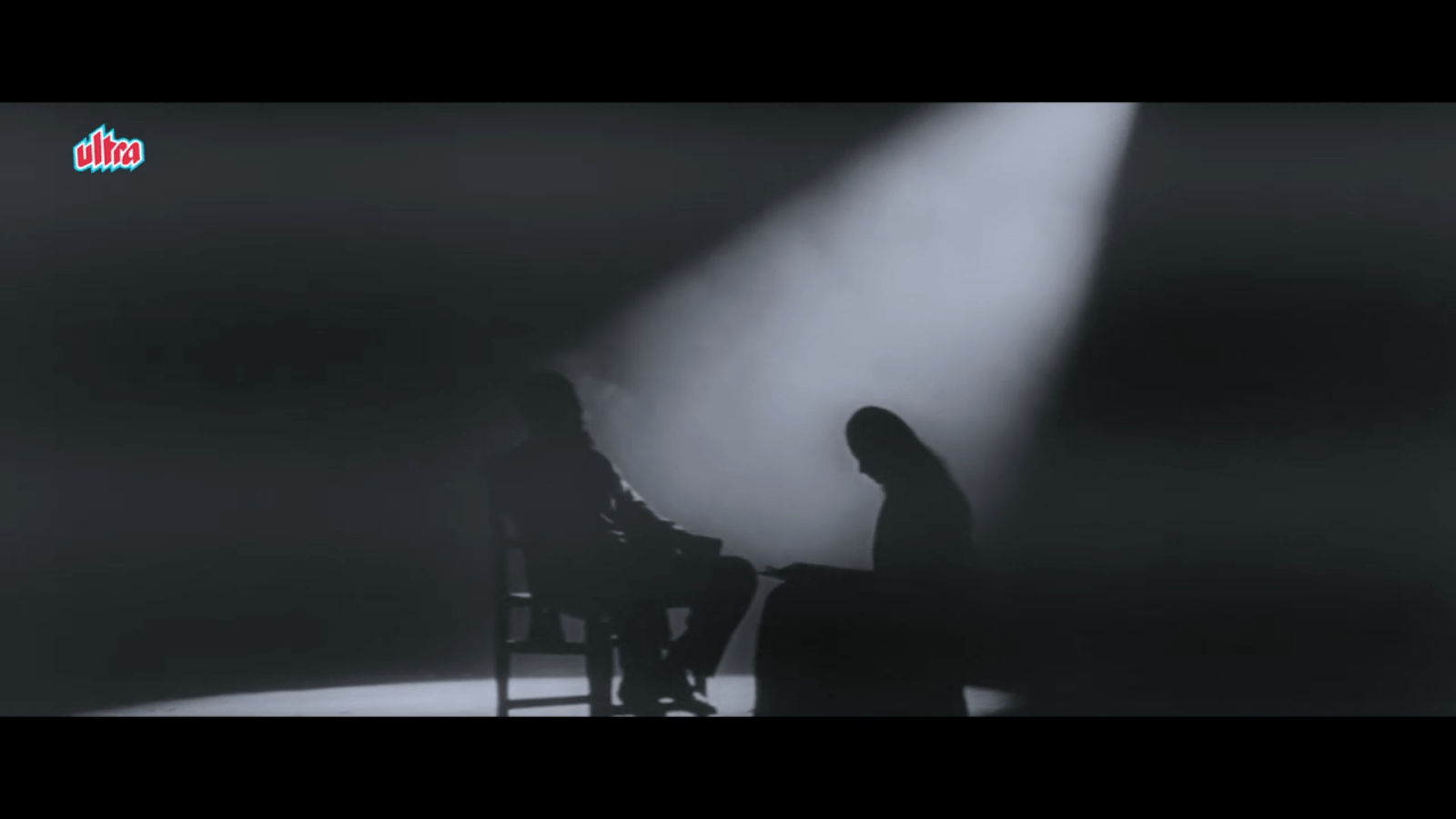
Experimental use of light is one of the major highlights in Kaagaz Ke Phool
In the scene where Suresh gives Paro’s dialogues to Shanti and asks him to perform as a part of her screen test, Guru Dutt’s visionary mind behind directing this scene is visible. Suresh is sitting on the director’s chair while Shanti is sitting on the floor. Separating them is the light that is entering diagonally through the ventilator above. Here, Guru Dutt is the ‘guru’ (teacher) while Shanti is his student here. It’s the reference to the ‘guru-shishya parampara’. The light separating them can also be a metaphor for the Almighty who would create harsh circumstances in both the lives which would eventually separate both the lovers. If you observe it more clearly, the film that Suresh is going to make is Devdas. Shanti is his Paro. By the end of Kaagaz Ke Phool, we can actually see Suresh consumed in too much alcohol when his decline begins. Much like Paro, Shanti reaches out to Suresh, requesting him to leave alcohol and return to filmmaking.
Guru Dutt used to decide the shots himself. Before directing, he would always decide each and every thing about a particular shot – close ups, angles, lights etc. His involvement in the composition of a shot was such that only a little was left to do for his cinematographer V.K. Murthy. In Kaagaz Ke Phool, Murthy got his ‘Midas touch’ to the frames and immortalised the film with magnificent shots making the effective use of light and shadow. But one thing which deserves another piece and a whole new book on its composition, framing and picturisation is the song ‘Waqt Ne Kiya Kya Haseen Sitam.’
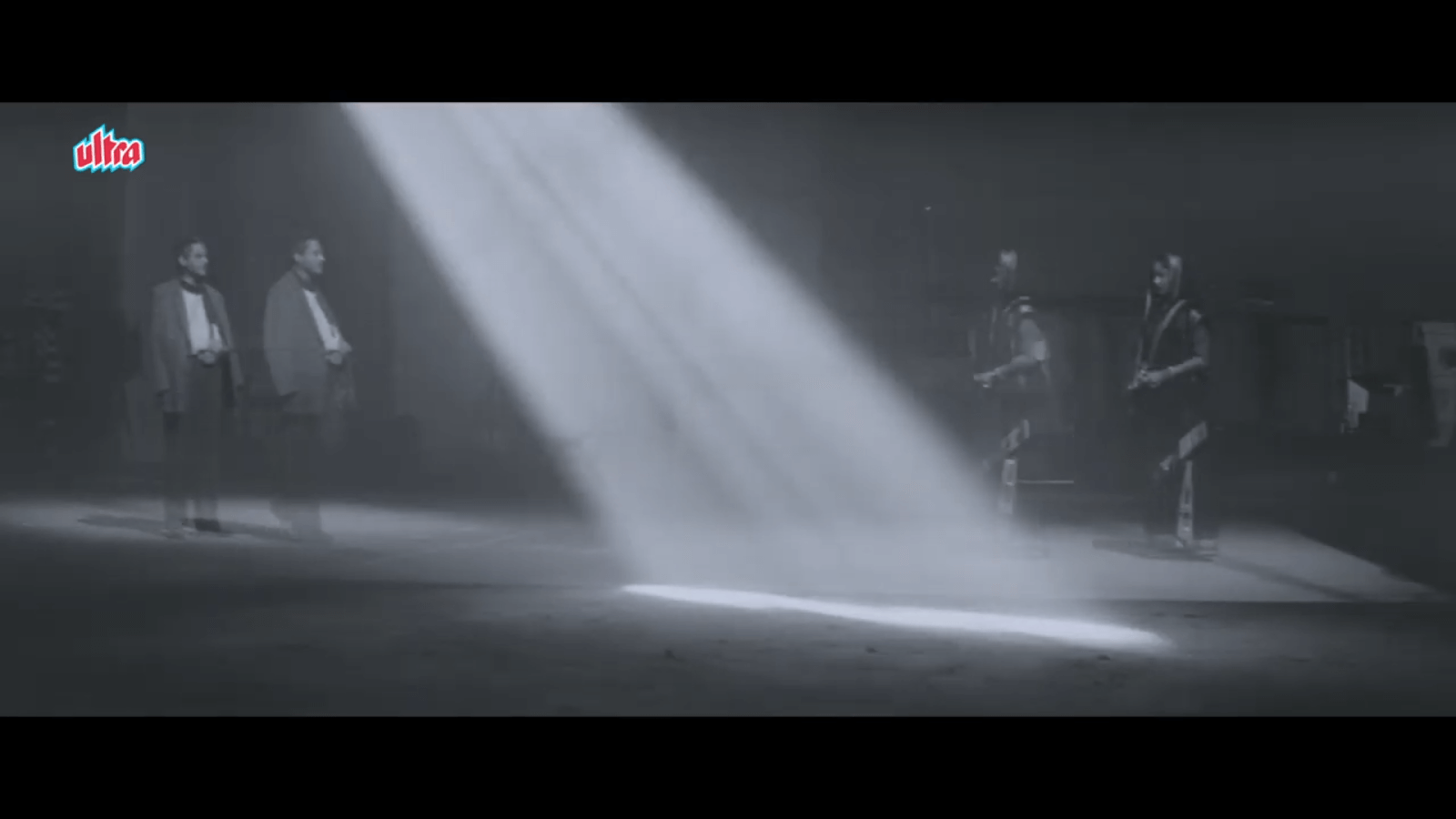
V.K. Murthy’s genius cinematography provided some rare and brilliant results in Kaagaz Ke Phool
Like Guru Dutt’s earlier film Mr. and Mrs. 55, Kaagaz Ke Phool was also shot in Mehboob Studios. Naturally, Dutt and Murthy knew the studio inside out. The studio had a sloping roof and a terrace and a skylight. As the filmmaker knew the interiors of the studio he got a huge mirror and a few smaller ones to create an effect which was never used before for any song. He suggested that the larger mirror should be placed on the terrace in such a way that the sunlight would fall on it and get deflected to the smaller ones acting as the reflectors. Those reflectors would further send the beam of light into the studio through the skylight. The idea worked and brought out a tremendous result which is visible in the song.
This song also brings out the emotions of the characters beautifully. It was an experimental one at that time also because of its picturisation. Suresh and Shanti have feelings for each other, but they are unable to express it. They are bound by the circumstances and restrictions imposed by the society. Prior to the song, we see Shanti knitting a sweater for someone. When Suresh asks her who she is knitting for. She smilingly replies, “Hai koi”. She doesn’t reveal the name and only leaves the man guessing. Further during the song, their silence converses throughout and their inner desires become evident as we see the image of two souls walking towards each other. They are mentally and emotionally each other’s even if they can’t be physically together.
Guru Dutt is known to infuse music or songs into the narrative. He places the songs in a manner that they don’t look unnecessary, rather they either move the plot ahead or provide something substantial to the ongoing narrative. The title and theme song of Kaagaz Ke Phool, ‘Dekhi Zamane Ki Yaari’ is used throughout the film. The song depicts the main mood or theme of the entire film and comes at apt places where we are told about the thought process of the protagonist, the shift in the mood and the development in the character. It is interesting to see how the song begins at the very beginning of the film when Suresh is inside the studio and goes through the entire film and later ends in the same studio. ‘Dekhi Zamane Ki Yaari’ seems like an elegy written for Suresh. In one scene where Shanti comes to convince Suresh to return to filmmaking, both stand up and look into each other’s eyes as they talk of the bond that they share and how circumstances have been cruel to them. As they hold each other, we hear the instrumental tune of ‘Waqt Ne Kiya Kya Haseen Sitam’ which symbolizes the thoughts ruling over their minds as both of them had given up before the fate.
The scenes involving both the leads elevate the film as we see different layers of their relationship. ‘Humne hamesha ek doosre ko samjha hai’, Suresh tells Shanti before she leaves her flat. Their level of understanding towards each other is also visible through the emotions their eyes express. Later in the film, where Shanti is back in the film industry and tries to convince Suresh to do the same, the latter refuses to budge and during the conversation tells Shanti, ‘Hum ek doosre ko kabhi ghalat nahin samajh sakte Shanti’. Here, we see the bond that they both share. Writer Abrar Alvi’s dialogues and Guru Dutt’s direction make this scene quite impactful as they both have understood the characters’ emotions and the result in this scene proves their genius.
CINEMATOGRAPHY
V.K. Murthy’s cinematography in Kaagaz Ke Phool is the soul of the film. This piece would be incomplete if I don’t mention the magnificent camerawork that beautified the frames because of the man behind it. The shaft of lights cutting in between the frames creating dramatic effects – the cinematography of Kaagaz Ke Phool is really one of its kind. Murthy made perfect use of a cinemascope lens for which he learnt a great deal of techniques before the filming began. He had taught himself some really new techniques which were used in Kaagaz Ke Phool. The experimental cinematography was so outstanding that it won Murthy Filmfare’s Best Cinematography Award in 1959 – his first ever Filmfare award – which was a perfect reward for his sheer dedication to learn something new.

Capturing the true emotions effortlessly: Waheeda Rehman and Guru Dutt in Kaagaz Ke Phool
Guru Dutt successfully experimented with some never seen before techniques. A risky step paid well, Kaagaz Ke Phool is now highly regarded as a film that is rich in cinematography and is now taught in film schools and institutions. Kaagaz Ke Phool has become an incredible lesson for cinematography for all the cinephiles and film students.
The purpose of adding a separate section for the cinematography of Kaagaz Ke Phool is to lay stress on the fact that much of the credit for the cult status of Kaagaz Ke Phool goes to its cinematography by Venkatarama Pandit Krishnamurthy. The starkly contrasted black and white images in the film depict the mood and the tension of the characters and the plot and carry the narrative forward through breathtaking visuals that say many things that words cannot.
CHARACTERS
SURESH SINHA (GURU DUTT): Guru Dutt’s character Suresh Sinha is a renowned filmmaker who loves to work freely and seeks creative freedom. He is serious about his craft and works hard on the story and the script. He is very particular about his characters and doesn’t like to compromise on the roles as he tells a leading actress not to wear make-up for the role of Paro. When the actress threatens to leave, he smiles and says “Thank you.” Guru Dutt played the character of Suresh Sinha effortlessly and I would like to believe he must have infused his own personality traits into the character for sure. Suresh is empathetic towards the underprivileged and never fails to take their side and speak for them whenever necessary. He understands their situation and problems quite well. His personal life is troubled though. His estranged wife Bina lives with her parents who haven’t allowed him to meet his daughter Pammi at her school. This rift between the two regarding the custody of their daughter goes to the court where he loses the case. Suresh is someone who loves simplicity and doesn’t have any affection for materialistic stuff. In a party, he chides Shanti for wearing heavy makeup which really doesn’t suit her. Suresh tells her about the attraction that her simplicity has which she doesn’t value. Suresh’s advocacy for everything simple is visible through this one scene. His love for Shanti is silent and it shows. He is in pain throughout and is juggling between his personal life and his professional life which merges later as he falls for Shanti who describes him perfectly prior to the song ‘Waqt Ne Kiya Kya Haseen Sitam’ saying “Wo bhi meri tarah akele hain”. Guru Dutt’s face wears all kinds of emotions necessary for the role with ease. Whether it is his encounter with his fame (the image of Suresh Sinha smoking the pipe is still fresh in the audience’s minds); his first encounter with Shanti on a rainy night; his happiness when he meets his daughter at her boarding school; his emotion evoking scenes with Shanti or whether as an old man, Guru Dutt portrays different layers of a man who rises high and then falls later owning the character we must have seldom seen on the silver screen.
SHANTI (WAHEEDA REHMAN): Waheeda Rehman had by now become a regular in Guru Dutt’s films or say, Guru Dutt Films. Having previously worked in C.I.D. (1956) and Pyaasa (1957), it was her third film with the production company and her second lead role after Pyaasa. Waheeda had already proved her mettle in Pyaasa and in Kaagaz Ke Phool, she does a convincing role as Shanti, whose rag to riches story also comes with a fair share of disappointments and sorrows. Shanti is a very simple girl who is straight-forward and honest. She has no one and thus he considers Suresh her world. The respect that he has earned in Shanti’s life is evident through his portrait that hangs on the wall of Shanti’s home. Shanti didn’t know acting and didn’t want to pursue it either but Suresh had found his Paro in her and wanted her only. Shanti had first met Suresh on a rainy night and then she didn’t know that was the beginning of a long association with the man who had handed over his coat to her. Through Suresh’s films, Shanti becomes a famous and popular actress. From the woman who didn’t have money to buy a warm coat for herself to the actress who is surrounded by her fans after her film’s premiere, Shanti’s rise to fame is a story that we all are familiar with. Like Suresh, she too falls for the man who is more than just her director and mentor. They both become each other’s support in life and pretty well understand the pain of loneliness. Shanti too loves Suresh but doesn’t declare it openly just like him. They both are aware of the circumstances around them. Shanti is practical and understands what can and cannot be achieved in life. For her, Suresh is her world. She respects him and loves him so much that she even leaves the industry sacrificing her fame and happiness thinking it would set things straight between Suresh and his wife. Waheeda Rehman is always known for her controlled and subtle performance. In Kaagaz Ke Phool, she plays the character of Shanti with utmost brilliance. A few scenes may also remind you of Gulabo from Pyaasa. Her eyes are quite expressive and they do all the talking when she is silent, especially in the song ‘Waqt Ne Kiya Kya Haseen Sitam’ where her eyes and smile tell everything that’s inside her heart.
PAMMI (BABY NAAZ/KUMARI NAAZ): Baby Naaz became a household name from Raj Kapoor’s Boot Polish (1954). She played the character of Belu alongside co-actor Rattan Kumar. Her performance earned her rave reviews and appreciation even from the Cannes Film Festival where the film was shown. As a child artiste, Baby Naaz (born as Salma Baig) became quite popular with films like Boot Polish, Yahudi (1958), Do Phool (1958), Bhai Behen (1959), Kaagaz Ke Phool etc. In Kaagaz Ke Phool, she plays the character of Pammi, the estranged daughter of Suresh. She is a school-going girl but intervenes in her father’s personal matters when the news of his affair with Shanti not only becomes the news headlines of a leading film magazine, but also a laughing stock for her classmates. Humiliated, she decides to take the matter in her own hands and runs from her boarding school to reach Shanti’s place. She confronts her and the dialogues between them show how Pammi blurs the line between the child and an adult. Pammi is quite possessive about her father. She doesn’t like him having an interest in any other woman who is not her mother. She becomes so blind in her father’s love that she doesn’t see any issue in her actions which eventually become the cause of her father’s sorrow. Baby Naaz/Kumari Naaz gives a layered performance as Pammi or Pramila Sinha. We first see her as Suresh goes to her school to meet her where she becomes so happy after seeing her father. Kumari Naaz’s accurate expressions in all the scenes provide her a good amount of support, so much that you can’t really believe that you are seeing a child artist on the screen amidst big personalities like Waheeda Rehman and Guru Dutt. She puts all the emotions of happiness, anger, frustration, sorrow and regret perfectly in place and with the right amount of balance which enhance her acting.
VEENA (VEENA SAPRU): Veena Sapru has acted in many hits such as Taj Mahal (1963) and Pakeezah (1972). In Kaagaz Ke Phool, she plays the role of Suresh’s estranged wife Veena. Veena is stubborn and lives with her parents in her home. They are rich and privileged which is depicted through their lavish home and also the cats and dogs that they own. Pammi’s custody is with Veena and the latter is not even allowed to meet her father as the school has Veena’s name as her guardian. Veena doesn’t like Suresh at all, more so because of his involvement in films. We come to know that it was Veena who left Suresh. She makes it clear that Pammi will live with her only. The conflict between the couple turns into a court case which is eventually won by Veena. Veena Sapru doesn’t get much screen time in Kaagaz Ke Phool but she makes her presence felt through her natural performance. She is someone who is also mocked by her own brother Rocky (played by Johnny Walker) who, through his punch lines, give her a reality check – ‘Shaadi se pehle Suresh samajhdaar tha. He was sensible, papa. Bewaqoofi to ye ki ki tumse shaadi ki.’ Veena, like her parents, is also of the view that the film industry is a dirty place and the fact that her husband is a filmmaker affects their reputation in the society. Veena’s squinting eyes, assertive tone and intimidating presence makes her performance lively.
ROCKY (JOHNNY WALKER): Johnny Walker is a regular in Guru Dutt’s films. He was a very close friend of the filmmaker and Guru Dutt always made sure to write a role for him in all his films. But, in Ten Years with Guru Dutt: Abrar Alvi’s Journey, Alvi reveals that after the release of Kaagaz Ke Phool, Guru Dutt realised that Johnny Walker was a misfit cast in the film and there was actually no need for the comedian in a rather serious film. Johnny Walker’s unique style though gives us comic relief and moments to laugh. He is Veena’s brother and Sir B.B. Verma’s son. But you can always find him mocking his entire family. In one scene, his father asks him how he reached the “cheap filmwallas” to which he replies “Taxi se!” Further, when his father expresses disappointment at this, and asks a very ‘important’ question that we often hear, ‘Wo log humaare bare mein kya sochte honge’, Rocky coolly replies, ‘Wo log humaare bare mein sochte hi nahin. They just ignore us.’ Rocky keeps giving reality checks to his family about certain things which also makes him a rebel in his own house. He falls for a vet named Julie who treats his horse Jimmy. Though he loves Julie, we can see that he does Johnny Walker’s perfect comic timing and subtle performance in Kaagaz Ke Phool makes Rocky the endearing character who makes us laugh while we are still dealing with the pain and sorrow of Suresh the film takes us through.
- AND MRS. VERMA (MAHESH KAUL AND PRATIMA DEVI): The rich couple Sir B.B. Verma and his wife portray the aristocratic characters who are always concerned about their reputations in the society. They are upper-class people who talk in English most of the time and seem to be more concerned about their pets than humans. Mahesh Kaul as Sir B.B. Verma understands the nuances of a rich man who is boastful of his privileges and seems arrogant. He wears a Jew cap and often adjusts his tie while roaring “Sir B.B. Verma…” His diction is clear, voice is loud and all his shocking moments are always accompanied by “Holy Moses!” B.B. Verma is ignorant of the film industry in the sense he thinks it’s a very dirty place filled with cheap people who are indulged in a ‘crime’ called Cinema. You will never see him sad or low as his face is always glowing with the pride that is probably out there because of the power of money he acquires. Mahesh Kaul was primarily a filmmaker and screenwriter who has made some legendary films in Hindi cinema such as Talaq (1958), Jeewan Jyoti (1953), Diwana (1967), Sapnon Ka Saudagar (1968) etc.
Pratima Devi’s dialogue delivery sounds like a typical mother of the 50s and 60s who is poor, needy and helpless. But look at her expensive saree and constant exclamation of “Dear Me!” and you will see a completely different mother. Just like B.B. Verma and her daughter Veena, she too despises the film industry for the same reasons. Through these characters, we see a contrast in their thoughts. Though they are rich, educated upper class people, their thoughts especially about cinema immediately pulls them backwards. Pratima Devi does justice to her unnamed character in Kaagaz Ke Phool even though with less screen time plays an important part of the story.
SONGS/MUSIC
Kaagaz Ke Phool is beautified with music by Sachin Dev Burman and lyrics by Kaifi Azmi and Shailendra (for the song “Hum Tum Jise Kehta Hai Shaadi”). The admirers of Guru Dutt’s cinema would know the importance of songs in his films. Guru Dutt had a unique way of incorporating the songs into the narrative that proved to be the carriers of the story. Not only this, his style of song picturization became so familiar that it was easy to spot whether he had directed a song sequence or not. Kaagaz Ke Phool has melodious songs that are still listened by one and everyone.
‘Dekhi Zamaane Ki Yaari’ is the first song which comes at the very beginning of the film and ten minutes into the film, we realise that it’s the theme song of the film which will play itself throughout. Kaifi Azmi was hired as the lyricist for Kaagaz Ke Phool after a rift between Sahir Ludhianvi and S.D. Burman during the making of Pyaasa where the former accused the latter of copying the tunes. Interestingly, Kaagaz Ke Phool was the last film where S.D. Burman gave the music for Guru Dutt’s film. The story goes that S.D. Burman was not in favour of making a film like Kaagaz Ke Phool which was based on the filmmaker’s own life. Guru Dutt didn’t agree with him and even though Sachin-da (as he was fondly called) gave the music for the film, he declared that it would be his last collaboration with Guru Dutt.
‘Dekhi Zamaane Ki Yaari’ talks about the disappointments, betrayal, pain that people give us and also about the passage of time which keeps on going and waits for none. The haunting music by S.D. Burman accompanies the beautiful lyrics written by poet Kaifi Azmi. The song gets its soul in the voice of legendary Mohammed Rafi Sb.
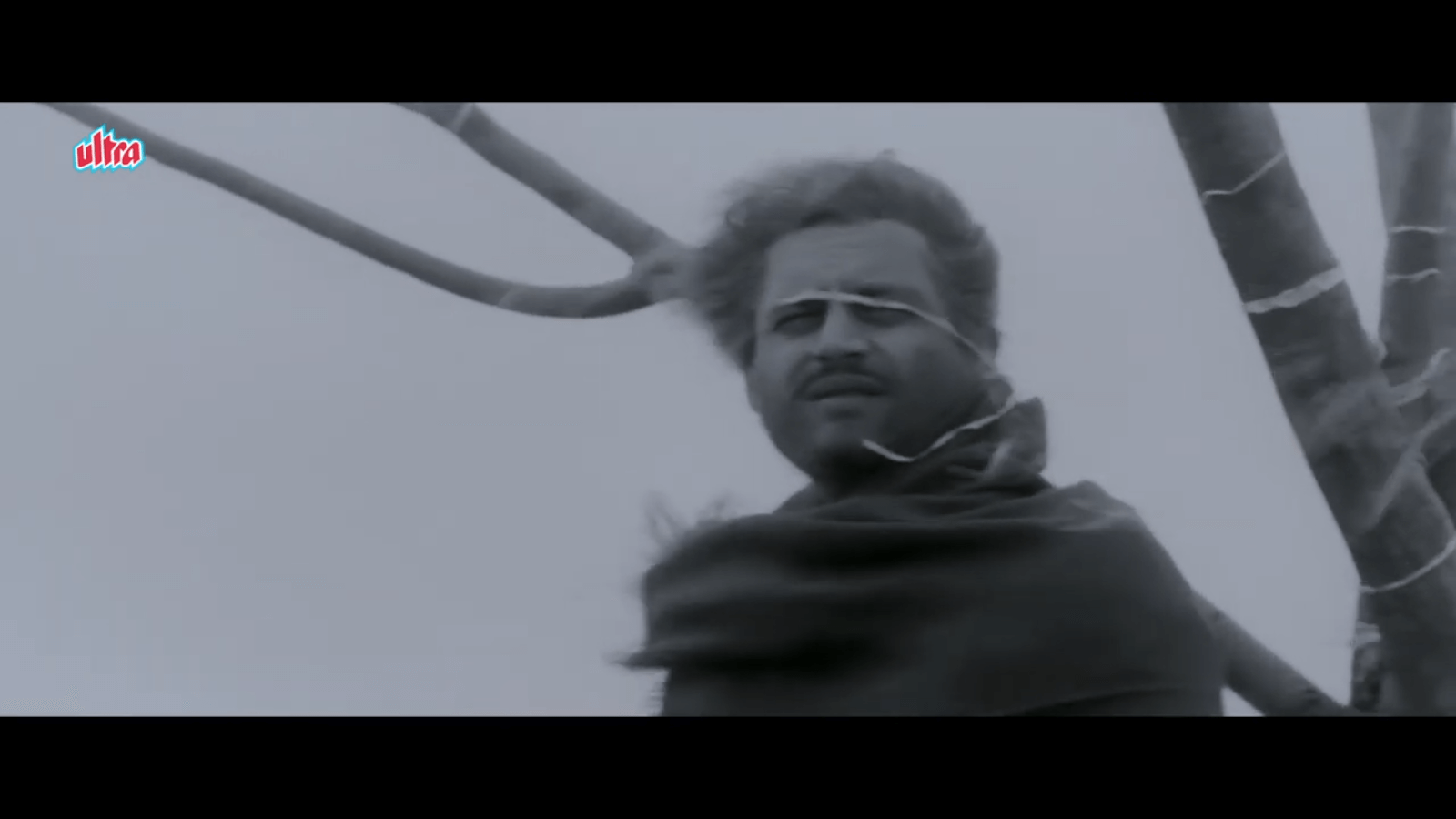
Dekhi zamaane ki yaari, bichhde sabhi baari-baari: Guru Dutt as the forgotten filmmaker Suresh Sinha
‘Kya leke milein ab duniya se, aansoo ke siva kuch paas nahin, ya phool hi phool hain daaman mein, ya kaanton ki bhi aas nahin’ depicts the sorrows of Suresh as he tastes both success and failure in his life. This song can also be seen as an ode or elegy to Suresh’s life, as written earlier. ‘Dekhi Zamaane Ki Yaari’ talks about the betrayal people give (‘Bichhde sabhi baari baari’), the time that never returns (‘Raat hai meherbaan ,hain bahaarein yahaan, raat gar dhal gayi, phir ye khushiyaan kahaan?’), the complaint that the character has from this world (‘Ek haath se leti hai duniya, sau haathon se le leti hai’) and the warning that we get in the end (‘Ud ja ud ja pyaase bhanwre, ras na milega khaaron mein, kaagaz ke phool jahaan khilte hain, baith na un gulzaaron mein). To some extent, this song also reminds us of two iconic songs of Pyaasa – ‘Jaane wo kaise log the jinke’ and ‘Ye duniya agar mil bhi jaaye to kya hai’ as both of them cover two aspects of this song – rejection and cruelty of the society.
The next song in the film is ‘San San San Lo Chali Hawa’. It reminds me of the song ‘Peechhe Peechhe Duniya Hai Aage Aage Hum’ from Pyaasa to some extent due to a similar setting – a group of youngsters riding on a vehicle singing the song as they follow the lead pair. In Pyaasa, if it was Vijay and Meena’s college mates riding on the bicycles and singing the song, here these youngsters are assistants to Suresh who is in a car ahead of them with Shanti. This song urges to let go of all the tension and chaos for a while and listen to the blowing wind and the song that nature is singing (a scene where all the pages of the script are carried away by the wind and Suresh is unable to hold them represents this situation). Guru Dutt’s close friend and popular comedian Mehmood has a cameo in this song.
The haunting yet beautiful rendition by Geeta Dutt comes in the form of the iconic song ‘Waqt Ne Kiya Kya Haseen Sitam’. The song is beautifully sung by Geeta Dutt, penned by none other than Kaifi Azmi and composed by legendary S,D. Burman. The trio has given one of the most memorable songs of Hindi cinema. Even though people might not know of the gem that Kaagaz Ke Phool is, there is no one unfamiliar with this melodious song. Guru Dutt is always known for using the song to carry forward the narrative. This song comes at a point where Shanti feels for his mentor and friend Suresh. She is knitting a sweater which is supposedly for him only. The song is in Geeta Dutt’s voice, meaning it clearly expresses Shanti’s emotions as she has found herself in this beautiful ‘sitam’ of time which has decorated her heart with the love for someone who is alone just like her.
‘Beqaraar dil is tarah mile, jis tarah kabhi hum juda na the’ describes her ecstasy Shanti is feeling after having Suresh in her life. To her, it seems like they have known each other since forever. I have already discussed the cinematography in this song. It’s one of the best examples of cinematography in Hindi cinema. The entire song plays in the background and through the expressions of both Shanti and Suresh, we get to know the state of their minds. ‘Jaayenge kahan soojhta nahin, chal diye magar raasta nahin’ describe Shanti’s dilemma and uncertainty of her mind in the path of love. She has entered into this realm of love but doesn’t know where to go from here. ‘Waqt Ne Kiya…’ is a song which feels like a love anthem. Beautifully shot by V.K. Murthy, brilliant direction by Guru Dutt, melodiously sung by Geeta Dutt with wonderful and thought-provoking lyrics by Kaifi Azmi and composed soulfully by S.D. Burman, this song stands the test of time.
‘Hum Tum Jise Kehta Hai Shaadi’ by Mohammed Rafi is the song picturised on Johnny Walker. Guru Dutt, in all his films starring Johnny Walker, has always reserved a song for the legendary comedian. Although Dutt later regretted casting Walker in Kaagaz Ke Phool as his role felt quite unnecessary, he yet again gifted him a song where he would challenge or rather criticise the institution of marriage by giving the simple reason that it binds you (‘Mind you! Jaayegi azaadi). Mohammed Rafi has sung for so many actors and some non-actors as well. He had this ability to change his tone and voice according to the actor who would lip-sync to his songs. Johnny Walker does full justice to this song with his mannerisms and facial expressions. Penned by Kaifi Azmi and composed by S.D. Burman, the song can also be seen as a comic relief in otherwise gloomy film.
‘Ulte Seedhe Daanv Lagaaye’ is a song by Asha Bhonsle and Mohammed Rafi. Picturised on Waheeda Rehman, the song comes at a point where Suresh has lost his everything – Shanti and Pammi. He loses interest in filmmaking and consumes a lot of alcohol. He reaches quite late on set which affects his creativity and others’ schedules as well. Asha Bhonsle’s chirpy voice accompanied by that of Rafi’s creates a beautiful song about the injustices and games that life plays with us. We often think things are always in our hands and everything is always going to be okay but that is not the case. Suresh begins imagining Shanti instead of his actress and unknowingly reaches out to her, thus ruining the shot. In the end, he calls for a pack-up, which is symbolic of his own time that nears its end. Written by Kaifi Azmi and composed by S.D. Burman, the song which tells us nothing is permanent and we should be grateful for what we have. It makes a mockery of those who become arrogant and careless after possessions and think it’s going to be there with them for the rest of their lives.
The last song in the film is ‘Ek, Do, Teen’. Shanti has left the world of glamour and has started teaching the kids in a village. Sung by Geeta Dutt, this song is basically a ‘children’s song’ written by Kaifi Azmi through which Shanti is teaching numbers and alphabets to the kids while also telling them a tale. The song has its own highs and lows. At one point the lyrics tell us how Shanti is missing Suresh and their bond (Chheena ek dooje ka sahaara…ek bichhda tanha-tanha…). Later, the song catches its happy tune again towards the end as Shanti, clad in a white saree, is surrounded by the kids.
CLOSING THE CURTAIN
Kaagaz Ke Phool is a story of love, loss and freedom – either on personal or professional front. Guru Dutt’s masterpiece saw the actual light of the day in the 1980s, decades after his untimely death in 1964, in Germany. It was since then that this film gained cult status and its cinematography is discussed in various film schools everywhere. Guru Dutt’s commentary on the hypocrisy and greed prevalent in the society travelled all the way from his previous film Pyaasa and culminated in Kaagaz Ke Phool. The problems and issues are the same, only the setting is different. This also makes us understand that on some point, everyone is facing the same issues regardless of class or society. Kaagaz Ke Phool is a gem in Dutt’s filmography starring himself in the lead opposite graceful Waheeda Rehman. Its cinematography by V.K. Murthy is one of the strongest points of the film and beautiful music and lyrics by S.D. Burman and Kaifi Azmi respectively is the icing on the cake. The film mirrors Dutt’s own life and his personal relationship that was in jeopardy. Unfortunately, the ace filmmaker isn’t alive to see how his film is considered a masterpiece and a lesson today for the aspiring filmmakers and cinegoers alike. If only he were here, I wish!


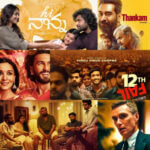





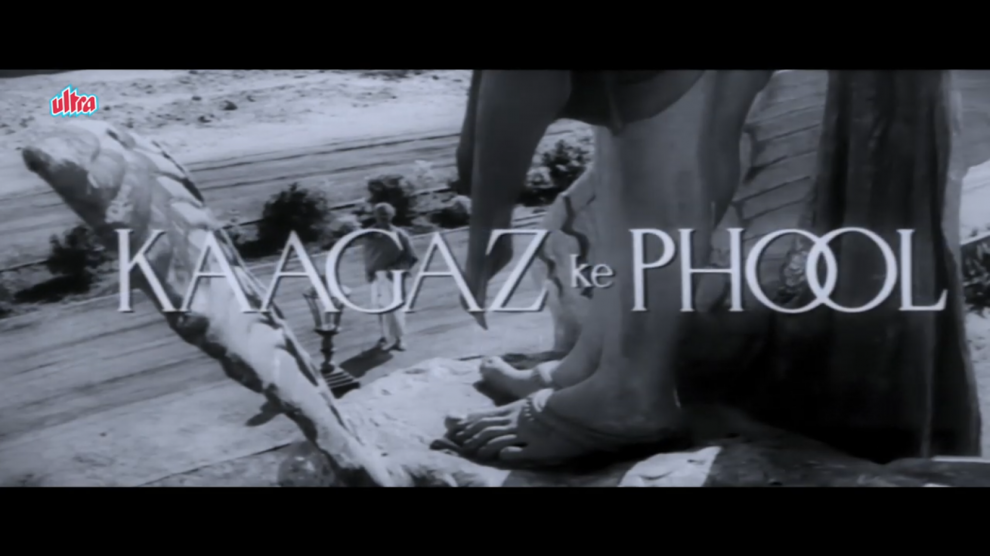


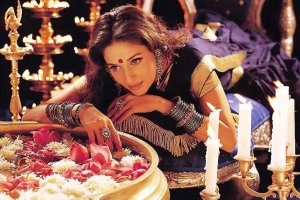



Add Comment